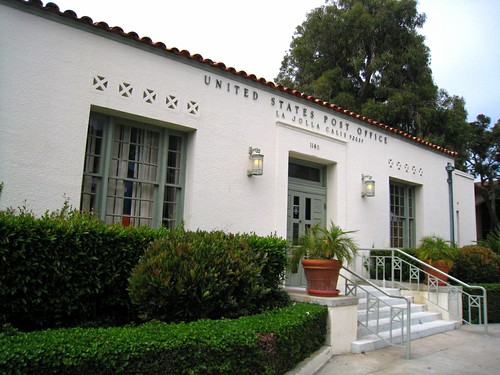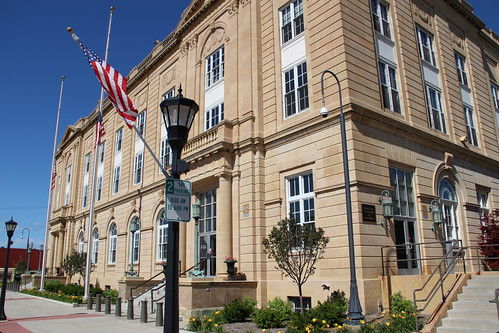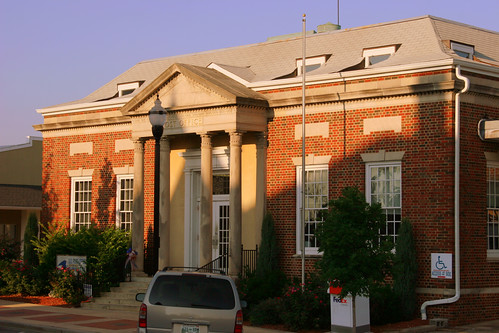Why historic post offices matter, and what might help save them

Posted January 22, 2014 at 1:21PM
When a city or town loses a historic building in its center, it loses a piece of its identity, part of the “there” that communities must have to distinguish themselves, to be cared for and loved. It is important, after all, that good places be not just sustainable but also sustained.
In America, nearly every city and town has, or at least used to have, at least one iconic type of building, frequently historic in character, that supports both the community’s character and its downtown vitality. I’m talking about the humble post office. Unfortunately, modern communication options being what they are, the functions of the post office aren’t as singular as they once were. As a result, business and revenues for the US Postal Service have dropped off, and the Service has begun to close facilities as a result. The abandonment of historic downtown facilities not only weakens downtowns, some already weakened by decades of disinvestment; it also diminishes a community’s legacy, its continuity with its past.
According to multiple reports, the Postal Service is moving to shutter over 4,000 post office buildings around the country.
This would be problem enough, but there is also a kind of double whammy at work here: USPS has also for some time been moving its facilities out of city centers and to the suburbs. Never mind the executive orders that Lee Epstein and I detailed in our article last year about the location and design of federal facilities. Those orders may encourage federal administrators to locate offices in historic downtown properties, but they tend to be “honored” in the breach.
Given the economic realities the Postal Service faces, there may be limits to what can be done about the trend, which has particularly serious consequences for smaller cities and rural communities. But whatever sales take place should at least be handled in a way that studies the alternative of retaining the facilities and, particularly, saves the historic character of the buildings. Some lawmakers are beginning to insist that USPS do exactly that.
In 2012, the National Trust for Historic Preservation named historic US Post Office Buildings, as a category, on its annual list of America’s most endangered historic places. The Trust’s statement on the issue was clear in articulating the problem:
“Across the country, many historic post offices have already been closed, while many others are threatened by the Postal Service’s failure to establish a clear and consistent process for transferring these buildings to new owners. Local preservationists, city officials, potential developers, and others willing to rehabilitate former post offices for new uses often are frustrated by the lack of information and guidance from the Postal Service.
“The National Trust recognizes the Postal Services’ need to address its budget issues by consolidating and transferring ownership of certain post office buildings. However, the lack of a transparent and uniform national process from the Postal Service—one that follows federal preservation laws when considering disposal of these buildings—is needlessly placing the future of many historic post office buildings in doubt.”
Can we at least have a fair, clear and consistent process here?

Oregon Congressman Earl Blumenauer has long understood the symbolic and functional importance of post offices, and introduced a bill over a decade ago that would require the Postal Service to consult with residents and obey local land-use-zoning regulations before closing, relocating or building post offices. Blumenauer has been concerned that, without legislation, USPS may argue that it is not subject to local land use law under the legal doctrine of sovereign immunity. “Many post offices are key to historic downtowns and neighborhoods and should be used as a way to strengthen the community fabric,” the Congressman told Aimee Curl in the Daily Journal of Commerce.
The American Planning Association issued a strong letter of endorsement for the concept:
“The Postal Service has too often closed or relocated facilities in ways that abandon service for some communities, vacate historic structures in downtown areas, and contribute to urban sprawl without providing for adequate community involvement in the decision-making process. This measure gives local citizens a greater voice in decisions about the location of postal facilities and ensures that local plans addressing growth management, land use, traffic congestion, environmental protection, downtown revitalization and historic preservation are respected by the Postal Service.”
The Blumenauer bill never went anywhere, and the issue remained dormant for several years. But the issue has been addressed again in the recently passed omnibus federal spending bill. According to an article written by Anna Hiatt and published in The Washington Post, a provision of the bill calls for a moratorium on further sales of historic post offices while reports on the subject are pending from the Advisory Council on Historic Preservation and USPS’s Office of Inspector General. Hiatt quotes New York Congressman José Serrano as saying that “I understand the USPS has a serious revenue problem . . . but selling off historic properties to the highest bidder without following the appropriate procedures is completely unacceptable.”
Serrano is upset over news that the USPS has gone ahead with a request for bids on the historic Bronx General Post Office building, Hiatt reports, despite community opposition. The Bronx building contains historic murals by artists Ben Shahn and Bernarda Bryson Shahn (many older post offices contain murals from the 1930s). The building’s exterior has been protected as a historic landmark since 1976 and last year, after community advocacy, the protection was extended to the murals as well.
The National Trust’s statement summarizes the case:
“Local post office buildings have traditionally played an essential role in the lives of millions of Americans. Many are architecturally distinctive, prominently located, and cherished as civic icons in communities across the country. Unless the Postal Service establishes a transparent, consistent, and preservation-sensitive process for these buildings, a significant part of the nation’s architectural heritage remains at risk.”
I agree. Hiatt’s article warns, however, that USPS is pushing a proposal to exempt post office sales and abandonment from the requirement of the National Environmental Policy Act that federal agencies study the environmental impacts of pending decisions before implementing them. That’s hardly encouraging.
Related posts:
- Is the 'traditional' downtown a thing of the past? Is that OK? (December 18, 2013)
- Traditional downtowns reconsidered: some further thoughts (January 2, 2014)
- The case for building on a city's historic assets (April 29, 2013)
- Meet the nation's biggest landlord (and developer) (with Lee Epstein) (February 6, 2013)
- The green dividend from reusing older buildings (January 24, 2012)
- The importance of legacy to sustainability (November 28, 2011)
- The greenest (historic) building is the one that's in the right context (June 16, 2011)
Move your cursor over the images for credit information.




